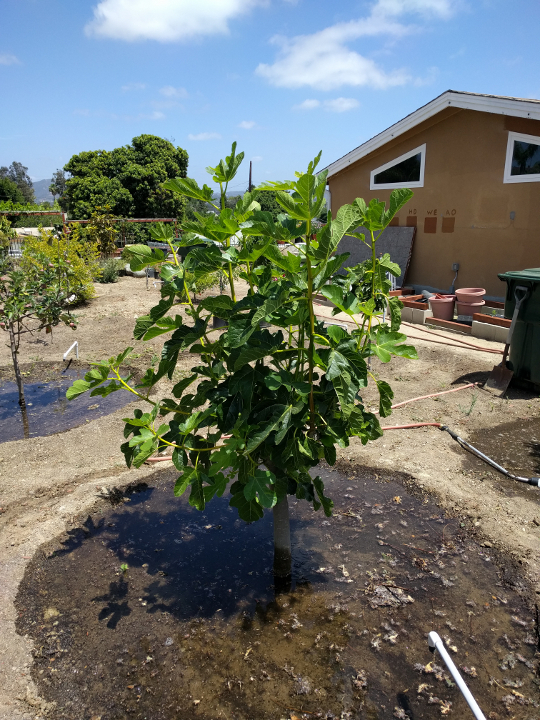The Japanese method appears to be the most dramatic form of this type of pruning. My situation is a lot different, as I have to grow in containers. I will let them grow out a bit more than Richard, but I guess I’ll be doing the same thing eventually. A point will come I’ll need to prune for size. Always back to the same point. I’m going to have to experiment, also some with good breba crops the approach needs to be different.
In my climate the quality of the breba crop is always poor and so the Japanese method is how I insure a good quality crop. I first read about in the Fruit Gardener a decade ago and then discovered it is also used by Jon at Encanto Farms (figs4fun forum).
Here’s the progress as of today. Figs have begun to form, mostly the size of peas at the moment.

The top of the tallest whip is now 7 foot from the ground.

I might be coming around to the “Japanese” method. Nice job! 
Here’s a pair of ripening figs on my Panaché, one striped and the other not. I get a few unstriped ones every year 
Deleted
9 feet high.

Beautiful fruit you’ve got.
Panache is the best fig I’ve ever eaten where I actually knew what they were by appearance and label-- and that’s from the grocery-- probably shipped here from California.
I think it’s the best of the “strawberry” flavor figs. 
I’m eating mine from July 24, the same with Desert King; Peter’s Honey and Black Jack started even 10 days earlier. Our heat helps figs to ripen fast. They still go strong, I expect at least 2-3 more weeks of fig harvest.
That’s great looking fig. I hope you won’t mind if I ask a general fig question here. You see, I have some figs that I’ve cut off all the shoots coming out of the ground except one, so they look basically like a tree. I have other figs that I’ve left most all of the growth coming out of the ground- as many as 5-7 “sprouts” that have grown very large. The figs I let do this are more “bush” than tree.
Anyway, forgetting about aesthetics for the moment and focusing only on yield and plant health and long-term viability, which is the best way to grow figs- as a bush or as a tree? Thanks.
The tree method is viable only where the trees don’t freeze back in winter. Even then it will likely take some pruning to maintain a single trunk. With freeze damage mine just spread out more each yr, ie more shoots. Yieldwise either can work but it’s really like comparing apples and oranges. It’s not a fair fight, advantage to the unfrozen tree.
Most figs are grown in their natural form, which is as a bush. The main
advantage is the increased yield, which is why you grow figs in the first
place. If you grow them as a tree, it means increased work in constantly
pruning, in order to maintain the tree shape, and if the tree freezes back,
the roots will push up bush formed shoots.
I expect successive ripening on my figs at least through October.
This may be a silly question but do they taste the same?
Yes 



